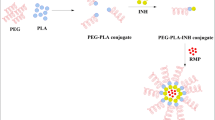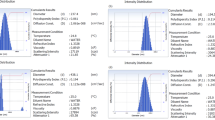Abstract
Purpose
First line antiTB drugs have several physical and toxic manifestations which limit their applications. RIF is a hydrophobic drug and has low water solubility and INH is hepatotoxic. The main objective of the study was to synthesize, characterize HPMA-PLA co-polymeric micelles for the effective dual delivery of INH and RIF.
Methods
HPMA-PLA co-polymer and HPMA-PLA-INH (HPI) conjugates were synthesized and characterized by FT-IR and 1H–NMR spectroscopy. Later on RIF loaded HPMA-PLA-INH co-polymeric micelles (PMRI) were formulated and characterized for size, zeta potential and surface morphology (SEM, TEM) as well as critical micellar concentration. The safety was assessed through RBC’s interaction study. The prepared PMRI were evaluated through MABA assay against sensitive and resistant strains of M. Tuberculosis.
Results
Size, zeta and entrapment efficiency for RIF loaded HPMA-PLA-INH polymeric micelles (PMRI) was 87.64 ± 1.98 nm, −19 ± 1.93 mV and 97.2 ± 1.56%, respectively. In vitro release followed controlled and sustained delivery pattern. Sustained release was also supported by release kinetics. Haemolytic toxicity of HPI and PMRI was 8.57 and 7.05% (p < 0.01, INH Vs PMRI; p < 0.0001, RIF Vs PMRI), respectively. MABA assay (cytotoxicity) based MIC values of PMRI formulation was observed as ≥0.0625 and ≥0.50 μg/mL (for sensitive and resistant strain). The microscopic analysis further confirmed that the delivery approach was effective than pure drugs.
Conclusions
RIF loaded and INH conjugated HPMA-PLA polymeric micelles (PMRI) were more effective against sensitive and resistant M tuberculosis. The developed approach can lead to improved patient compliance and reduced dosing in future, offering improved treatment of tuberculosis.








Similar content being viewed by others
Abbreviations
- Ar:
-
Aromatic
- CMC:
-
Critical micelle concentration
- DCC:
-
N,N′-dicyclohexylcarbodiimide
- DCM:
-
Dichloromethane
- EDC:
-
N-(3-dimethylaminopropyl)-N′-ethylcarbodiimide
- ETH:
-
Ethambutol
- HPI:
-
HPMA-PLA-INH conjugates
- HPMA:
-
N(2-hydroxypropyl) methacrylamide
- INH:
-
Isoniazid
- MDR-TB:
-
Multidrug-resistant TB
- PLA:
-
Poly lactic acid
- PMRI:
-
RIF loading in HPMA-PLA-INH conjugates
- PYZ:
-
Pyrazinamide
- RIF:
-
Rifampicin
- SEM:
-
Scanning electron microscopy and
- TB:
-
Tuberculosis
- TEM:
-
Transmission electron microscopy
References
Mehanna MM, Mohyeldin SM, Elgindy NA. Respirable nanocarriers as a promising strategy for antitubercular drug delivery. J Control Release. 2014;187:183–97.
World Health Organization. Global Tuberculosis Report. 2015.
Shah U, Jasani A. UV spectrophotometric and Rp-HPLC methods for simultaneous estimation of isoniazid, rifampicin and piperine in pharmaceutical dosage form. Int J Pharm Pharm Sci. 2014;6(10):274–80.
Rajan M, Raj V. Encapsulation, characterisation and in-vitro release of anti-tuberculosis drug using chitosan-poly ethylene glycol nanoparticles. Int J Pharm Pharm Sci. 2012;4(4):255–9.
Du Toit LC, Pillay V, Danckwerts MP. Tuberculosis chemotherapy: current drug delivery approaches. Respir Res. 2006;7:118.
Gandhi NR, Shah NS, Andrews JR, Vella V, Moll AP, Scott M, et al. Am J Respir Crit Care Med. 2010;181:80.
Solaro R, Chiellini F, Battisti A. Targeted delivery of protein drugs by nanocarriers. Materials. 2010;3:1928–80.
Mourya VK, Inamdar N, Nawale RB, Kulthe SS. Polymeric micelles: general considerations and their applications. Ind J Pharm Edu Res. 2011;45(2):128–38.
Talelli M, Rijcken CJF, Van Nostrum CF, Storm G, Hennink WE. Micelles based on HPMA co-polymers. Adv Drug Deliv Rev. 2010;62:231–9.
Kwon GS, Okano T. Polymeric micelles as new drug carriers. Adv Drug Deliv Rev. 1996;21:107–16.
Rapoport N. Physical stimuli-responsive polymeric micelles for anti-cancer drug delivery. Prog Polym Sci. 2007;32:962–90.
Yokoyama M. Clinical applications of polymeric micelle carrier systems in chemotherapy and image diagnosis of solid tumors. J Exp Clin Med. 2011;3(4):151–8.
Ulbricha K, Subra V, Strohalma J, Plocova D, Jelınkova M, Ihova BR. Polymeric drugs based on conjugates of synthetic and natural macromolecules synthesis and physico-chemical characterisation. J Control Release. 2000;64:63–79.
Ma G, Zhang C, Zhang L, Sun H, Song C, Wang C, et al. Doxorubicin-loaded micelles based on multiarm star-shaped PLGA–PEG block copolymers: influence of arm numbers on drug delivery. J Mater Sci Mater Med. 2016;27(17):1–15.
Huang D, Li D, Wang T, Shen H, Zhao P, Liu B, et al. Isoniazid conjugated poly(lactide-co-glycolide): long-term controlled drug release and tissue regeneration for bone tuberculosis therapy. Biomaterials. 2015;52:417–25.
Wei Z, Hao J, Yuan S, Li Y, Juan W, Sha X, et al. Paclitaxel-loaded pluronic P123/F127 mixed polymeric micelles: formulation, optimization and in vitro characterization. Int J Pharm. 2009;376:176–85.
Gaucher G, Dufresne MH, Sant VP, Kang N, Maysinger D, Leroux JC. Block co-polymer micelles: preparation, characterization and application in drug delivery. J Control Release. 2005;109:169–88.
Khan I, Gothwal A, Sharma AK, Qayum A, Singh SK. Biodegradable nano-architectural PEGylated approach for the improved stability and anticancer efficacy of bendamustine. Int J Biol Macromol. 2016;92:1242–51.
Chen L, Xie Z, Hu J, Chen X, Jing X. Enantiomeric PLA–PEG block co-polymers and their stereocomplex micelles used as rifampin delivery. J Nanopart Res. 2007;9:777–85.
Raza K, Kumar N, Misra C, Kaushik L, Guru SK, Kumar P, et al. Dextran-PLGA-loaded docetaxel micelles with enhanced cytotoxicity and better pharmacokinetic profile. Int J Biol Macromol. 2016;88:206–12.
Scarano W, Souza PD, Stenzel MH. Dual-drug delivery of curcumin and platinum drugs in polymeric micelles enhances the synergistic effects: a double act for the treatment of multidrug-resistant cancer. Biomater Sci. 2014;3:163–74.
Rajera R, Nagpal K, Singh SK, Mishra DN. Toxicological study of the Primaquine phosphate loaded chitosan nanoparticles in mice. Int J Biol Macromol. 2013;62:18–24.
Singhai AK, Jain S, Jain NK. Evaluation of an aqueous injection of Ketoprofen. Pharmazie. 1997;52:149–51.
Franzblau SG, Witzig RS, Mclaughlin JC, Torres P, Madico G, Hernandez A, et al. Rapid, low-technology mic determination with clinical mycobacterium tuberculosis isolates by using the microplate alamar blue assay. J Clin Microbiol. 1998;36:362–6.
Huh KM, Lee SC, Cho YW, Lee J, Jeong JH, Park K. Hydrotropic polymer micelle system for delivery of paclitaxel. J Control Release. 2005;101:59–68.
Wu Y, Li M, Gao H. Polymeric micelle composed of PLA and chitosan as a drug carrier. J Polym Res. 2009;16:11–8.
Moretton MA, Glisoni RJ, Chiappetta DA, Sosnik A. Molecular implications in the nanoencapsulation of the anti-tuberculosis drug rifampicin within flower-like polymeric micelles. Colloids Surf B. 2010;79:467–79.
Singhvi G, Singh M. Review: in-vitro drug release characterization models. Int J Pharm Stu Res. 2011;2:77–84.
Gothwal A, Khan I, Gupta U. Polymeric micelles: recent advancements in the delivery of anticancer drugs. Pharm Res. 2016;33:18–39.
Gupta U, Sharma S, Khan I, Gothwal A, Sharma AK, Singh Y, et al. Enhanced apoptotic and anticancer potential of paclitaxel loaded biodegradable nanoparticles based on chitosan. Int J Biol Macromol. 2017;98:810–9.
Author information
Authors and Affiliations
Corresponding author
Ethics declarations
Conflict of Interest
The authors declare no competing financial interest.
Electronic supplementary material
ESM 1
(DOCX 698 kb)
Rights and permissions
About this article
Cite this article
Upadhyay, S., Khan, I., Gothwal, A. et al. Conjugated and Entrapped HPMA-PLA Nano-Polymeric Micelles Based Dual Delivery of First Line Anti TB Drugs: Improved and Safe Drug Delivery against Sensitive and Resistant Mycobacterium Tuberculosis . Pharm Res 34, 1944–1955 (2017). https://doi.org/10.1007/s11095-017-2206-3
Received:
Accepted:
Published:
Issue Date:
DOI: https://doi.org/10.1007/s11095-017-2206-3




